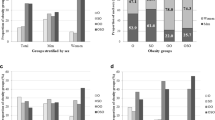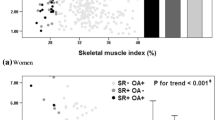Abstract
Introduction
To evaluate the differences in the associations of combinations of co-existent osteopenia, obesity, and/or sarcopenia with insulin resistance (IR) according to different criteria of obesity.
Materials and methods
Among 4500 Korean men and postmenopausal women who were aged ≥ 50 years and did not have diabetes mellitus, osteopenia, sarcopenia, and obesity were defined using bone mineral density, skeletal mass index, and body fat % (or BMI). Body composition groups were generated based on the combinations of these components. IR was defined using the HOMA-IR ≥ 2.5.
Results
When obesity was defined by body fat % and the relationships were adjusted for age, sex, education, and health behaviors, the odds ratios (ORs) for IR was highest in the groups with obesity and osteopenic obesity, followed by sarcopenic obesity and osteosarcopenic obesity, followed by osteopenia and sarcopenia, and followed by osteosarcopenia. When BMI was additionally adjusted, the ORs for IR were not significantly different between body composition groups except for osteopenia: those groups had higher ORs for IR compared to osteopenia. When obesity was defined by BMI, obesity co-existent groups had higher ORs for IR than the obesity non-coexistent groups. The ORs for IR were not significantly different within obesity co-existent groups or obesity non-coexistent groups.
Conclusions
Combinations of co-existent osteopenia, obesity, and/or sarcopenia had different associations with IR according to obesity classification methods and consideration of BMI adjustment. Osteosarcopenic obesity may not have a stronger association with IR compared to obesity only and obesity co-existent other conditions.
Similar content being viewed by others
References
Ilich JZ, Kelly OJ, Inglis JE (2016) Osteosarcopenic obesity syndrome: what is it and how can it be identified and diagnosed? Curr Gerontol Geriatr Res 2016:7325973
Ilich JZ, Kelly OJ, Inglis JE, Panton LB, Duque G, Ormsbee MJ (2014) Interrelationship among muscle, fat, and bone: connecting the dots on cellular, hormonal, and whole body levels. Ageing Res Rev 15:51–60
Kelly OJ, Gilman JC, Boschiero D, Ilich JZ (2019) Osteosarcopenic obesity: Current knowledge, revised identification criteria and treatment principles. Nutrients. https://doi.org/10.3390/nu11040747
Ilich JZ, Inglis JE, Kelly OJ, McGee DL (2015) Osteosarcopenic obesity is associated with reduced handgrip strength, walking abilities, and balance in postmenopausal women. Osteoporos Int 26:2587–2595
Szlejf C, Parra-Rodriguez L, Rosas-Carrasco O (2017) Osteosarcopenic obesity: prevalence and relation with frailty and physical performance in middle-aged and older women. J Am Med Dir Assoc 18:733.e1–733.e5
Chen X, Kong C, Yu H, Gong J, Lan L, Zhou L, Gong J, Liu P, Xu L, Deng Q (2019) Association between osteosarcopenic obesity and hypertension among four minority populations in china: a cross-sectional study. BMJ Open 9:2018–026818
Mo D, Hsieh P, Yu H, Zhou L, Gong J, Xu L, Liu P, Chen G, Chen Z, Deng Q (2018) Osteosarcopenic obesity and its relationship with dyslipidemia in women from different ethnic groups of China. Arch Osteoporos 13:65018-0481-1
Shanik MH, Xu Y, Skrha J, Dankner R, Zick Y, Roth J (2008) Insulin resistance and hyperinsulinemia: is hyperinsulinemia the cart or the horse? Diabetes Care 31:S262–S268
Karpe F, Pinnick KE (2015) Biology of upper-body and lower-body adipose tissue–link to whole-body phenotypes. Nat Rev Endocrinol 11:90–100
Goossens GH (2017) The metabolic phenotype in obesity: fat mass, body fat distribution, and adipose tissue function. Obes Facts 10:207–215
Srikanthan P, Karlamangla AS (2011) Relative muscle mass is inversely associated with insulin resistance and prediabetes findings from the third national health and nutrition examination survey. J Clin Endocrinol Metab. 96:2898–2903
Mesinovic J, Zengin A, De Courten B, Ebeling PR, Scott D (2019) Sarcopenia and type 2 diabetes mellitus: a bidirectional relationship. Diabetes Metab Syndr Obes 12:1057–1072
Kim K, Park SM (2018) Association of muscle mass and fat mass with insulin resistance and the prevalence of metabolic syndrome in korean adults: a cross-sectional study. Sci Rep 8:2703018-21168-5
Conte C, Epstein S, Napoli N (2018) Insulin resistance and bone: a biological partnership. Acta Diabetol 55:305–314
Bauer JM, Cruz-Jentoft AJ, Fielding RA, Kanis JA, Reginster JY, Bruyere O, Cesari M, Chapurlat R, Al-Daghri N, Dennison E, Kaufman JM, Landi F, Laslop A, Locquet M, Maggi S, McCloskey E, Perna S, Rizzoli R, Rolland Y, Rondanelli M, Szulc P, Vellas B, Vlaskovska M, Cooper C (2019) Is there enough evidence for osteosarcopenic obesity as a distinct entity? A critical literature review. Calcif Tissue Int 105:109–124
Korea centers for disease control and prevention. Guidelines for using the fifth national healthy and nutition examination survey (KNHANES V-3), 2012. In, osong, chungcheong buk-do, Republic of Korea
Kweon S, Kim Y, Jang MJ, Kim Y, Kim K, Choi S, Chun C, Khang YH, Oh K (2014) Data resource profile: the Korea National Health and Nutrition Examination Survey (KNHANES). Int J Epidemiol 43:69–77
Chen LK, Liu LK, Woo J, Assantachai P, Auyeung TW, Bahyah KS, Chou MY, Chen LY, Hsu PS, Krairit O, Lee JS, Lee WJ, Lee Y, Liang CK, Limpawattana P, Lin CS, Peng LN, Satake S, Suzuki T, Won CW, Wu CH, Wu SN, Zhang T, Zeng P, Akishita M, Arai H (2014) Sarcopenia in Asia: consensus report of the asian working group for sarcopenia. J Am Med Dir Assoc 15:95–101
Kelly OJ, Gilman JC, Boschiero D, Ilich JZ (2019) Osteosarcopenic obesity: current knowledge, revised identification criteria and treatment principles. Nutrients. https://doi.org/10.3390/nu11040747
Li Y, Wang H, Wang K, Wang W, Dong F, Qian Y, Gong H, Xu G, Li G, Pan L, Zhu G, Shan G (2017) Optimal body fat percentage cut-off values for identifying cardiovascular risk factors in mongolian and han adults: a population-based cross-sectional study in inner Mongolia. China. BMJ Open 7:e014675
The international association for the study of obesity and the international obesity task force. the asia-pacific perspective: Redefining obesity and its treatment. australia: IASO and IOTF, 2000
Chen X, Kong C, Yu H, Gong J, Lan L, Zhou L, Gong J, Liu P, Xu L, Deng Q (2019) Association between osteosarcopenic obesity and hypertension among four minority populations in china: a cross-sectional study. BMJ Open 9:e026818
Matthews DR, Hosker JP, Rudenski AS, Naylor BA, Treacher DF, Turner RC (1985) Homeostasis model assessment: insulin resistance and beta-cell function from fasting plasma glucose and insulin concentrations in man. Diabetologia 28:412–419
Lee YH, Kim SU, Song K, Park JY, Kim DY, Ahn SH, Lee BW, Kang ES, Cha BS, Han KH (2016) Sarcopenia is associated with significant liver fibrosis independently of obesity and insulin resistance in nonalcoholic fatty liver disease: nationwide surveys (KNHANES 2008–2011). Hepatology 63:776–786
Prado CM, Wells JC, Smith SR, Stephan BC, Siervo M (2012) Sarcopenic obesity: a critical appraisal of the current evidence. Clin Nutr 31:583–601
Ormsbee MJ, Prado CM, Ilich JZ, Purcell S, Siervo M, Folsom A, Panton L (2014) Osteosarcopenic obesity: the role of bone, muscle, and fat on health. J Cachexia Sarcopenia Muscle 5:183–192
Kim J, Lee Y, Kye S, Chung YS, Kim JH, Chon D, Lee KE (2017) Diet quality and osteosarcopenic obesity in community-dwelling adults 50 years and older. Maturitas 104:73–79
Acknowledgements
This work was funded by the National Research Foundation of Korea Grant funded by the Korean Government (NRF-2017S1A5B8066096).
Author information
Authors and Affiliations
Contributions
Author contributed to design this study, analyze the data, and write the manuscript.
Corresponding author
Ethics declarations
Conflict of interest
There are no conflicts of interest to declare.
Ethical approval
All procedures performed in studies involving human participants were in accordance with the ethical standards of the institutional and/or national research committee and with the 1964 Helsinki declaration and its later amendments or comparable ethical standards.
Informed consent
Informed consent was obtained from all individual participants included in the study.
Additional information
Publisher's Note
Springer Nature remains neutral with regard to jurisdictional claims in published maps and institutional affiliations.
About this article
Cite this article
Lee, K. Association of osteosarcopenic obesity and its components: osteoporosis, sarcopenia and obesity with insulin resistance. J Bone Miner Metab 38, 695–701 (2020). https://doi.org/10.1007/s00774-020-01104-2
Received:
Accepted:
Published:
Issue Date:
DOI: https://doi.org/10.1007/s00774-020-01104-2




